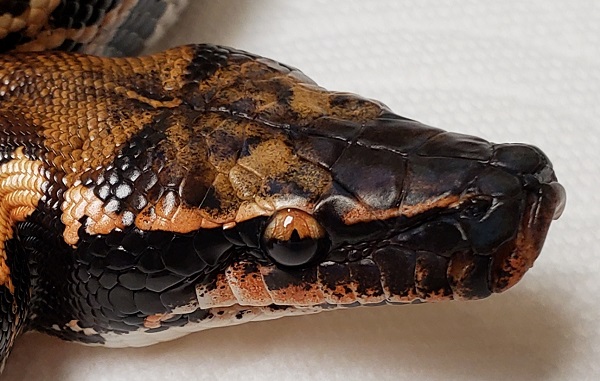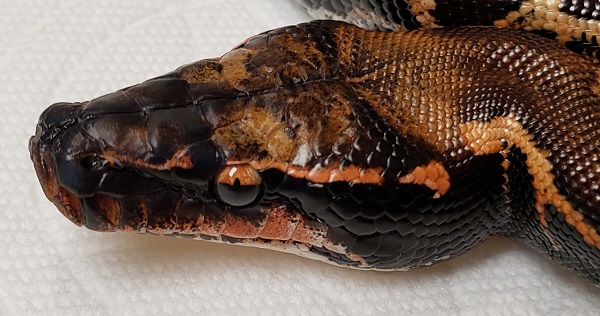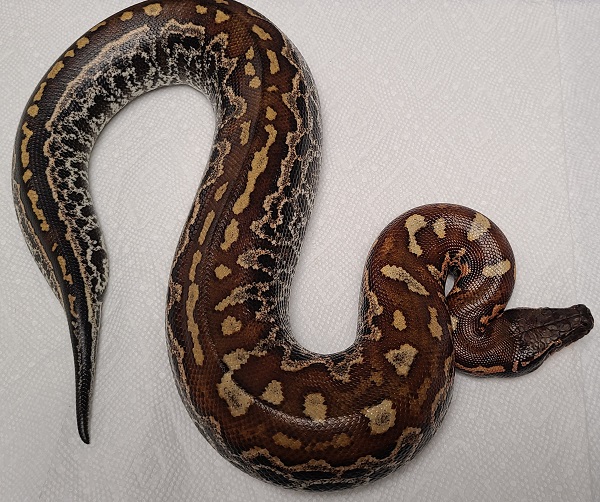07/23/2021 UPDATE 2021 BLOOD PYTHONS AT VPI!
What a difference a year makes, or in the case of a pandemic, a year plus 6 months and counting.
We of course could write about a lot of thoughts, but at this time we will stick to the topic at hand, because that is why you are reading the 2021 Blood Python update.
The focus of this update is an incredible morph of Blood Python called the Wrought Iron.
There has been a lot of interest in this project, and for good reason, the Wrought Iron is one of the coolest Blood morphs out there! We got the original Wrought Iron more than a decade ago. He had a beautiful and interesting appearance, and it has not changed in 13 years!
ORIGINAL MALE WROUGHT IRON 2008

This snake has never missed a meal, he is bulky, but still handles well, and weighs in at an impressive 9 pounds.
VPI Breeding Results Part 1
We bred the original male Wrought Iron to an adult female T+ Red Albino in multiple years. As in most of our pairings, when we have a pair that works, we stick with it, because we know the pair is compatible and we tend not to breed males to more than one female each year. For genetic diversity we would then take their offspring and breed them to other unrelated normal animals or different morphs to make combinations.
BREEDING, HATCHING, AND BABY WROUGHT IRONS FROM ORIGINAL MALE WROUGHT IRON MALE X T+ RED ALBINO FEMALE

When you start with a single animal of a special morph and there are no others that exist, all the animals in the project will be partially related. The Wrought Iron appearance is inherited as an incomplete dominant trait. When bred to the T+ Red Albino, the expected result is that the appearance of half the clutch is normal, and the other half is Wrought Iron. All of the offspring from this pairing are heterozygous for the T+ Red Albino trait.


In each of our first clutches we noticed 1 or 2 of the Wrought Iron babies in the clutch had a postocular scale or scales that jutted out about 1/2 to 1 mm over the edge of one of the eyes. It did not appear to affect the eye in any way, it looked more cosmetic. Other than the irregular shaped postocular scale, these babies were healthy and are now beautiful adult animals. In 2017, we repeated the breeding and again there was one Wrought Iron with the same postocular scale anomaly bordering one eye.
Decision Time
At this point we were getting a ton of requests for the Wrought Iron offspring! What to do?!
We were aware of previous observations by snake keepers over the past three decades of anomalies in a few recessive and incomplete dominant traits in Ball Pythons, Carpet Pythons and Boa constrictors, where some animals had morphological issues, including cosmetic issues, kinking, muscle deterioration, and non viability.
Blood Pythons breeding projects involving incomplete dominant traits have produced animals that have been bred multiple generations and have had proven longevity, even to the super generation.
Matrix x Matrix= “super” Ivory
Golden Eye x Golden Eye= “super” Magpie
Pollen x Pollen= “super” Flower
Frostbite x Frostbite = "super" Super Frostbite
To date among all of the Blood Python morphs, only the "super" Batik has shown minor tail kink issues and low egg viability. Chris and Alliey McAra (Giantkeeper Reptiles) have produced "super" Batiks with minor tail kinks, and those animals have been raised without issues.
In 2018 I was approached by Tim Bailey of Bailey and Bailey Reptiles at the NARBC show in Arlington, TX, about getting a Wrought Iron.
We discussed the situation and results resulting in this unusual postocular scale/s on one eye and he decided to get a female Wrought Iron 100% T+ het Red Albino. This was one of our babies that did not show the aberrant postocular.
At that point we decided to not sell any other animals until Tim weighed in after raising and breeding that female. In 2019 Tim got a male Wrought Iron 100% T+ het Red Albino with the idea of producing “supers.” This male did not show the aberrant postocular.
VPI Breeding Results Part 2
In 2019 we had our biggest clutch of animals from the cross between the male Wrought Iron and female T+ Red Albino. Again, some babies had the same issue where there were irregularly shaped scales that jutted ½ to 1mm out over one eye, the position of the affected scale/s was either postocular or supraocular.
At that point I called Tim to report that this really was something and we were not selling any animals other than the two he had, until we understood what exactly was going on. I sent photos of the animals over to Tim and decided not to breed any more animals until we heard from him about his results.
HERE ARE PHOTOS OF ANIMALS SHOWING COMPLETELY NORMAL SCALATION AROUND BOTH EYES AND OF IRREGULARLY SHAPED SCALES BORDERING ONE EYE OF WROUGHT IRON BABIES.
PHOTOS 1-16 VPI DAVID AND TRACY BARKER 2019
WROUGHT IRON NORMAL EYE SCALES

WROUGHT IRON NORMAL EYE SCALES

WROUGHT IRON WITH IRREGULARLY SHAPED SCALES BORDERING RIGHT EYE

WROUGHT IRON NORMAL EYE SCALES

WROUGHT IRON WITH IRREGULARLY SHAPED SUPRAOCULAR SCALE BORDERING RIGHT EYE

WROUGHT IRON NORMAL EYE SCALES

WROUGHT IRON WITH POSTOCULAR IRREGULARLY SHAPED SCALE BORDERING RIGHT EYE

WROUGHT IRON NORMAL EYE SCALES

WROUGHT IRON NORMAL EYE SCALES

WROUGHT IRON NORMAL EYE SCALES

WROUGHT IRON NORMAL EYE SCALES

WROUGHT IRON NORMAL EYE SCALES

WROUGHT IRON NORMAL EYE SCALES

WROUGHT IRON NORMAL EYE SCALES

WROUGHT IRON POSTOCULAR IRREGULARLY SHAPED SCALES BORDERING LEFT EYE

WROUGHT IRON NORMAL EYE SCALES

Photos of VPI Wrought Irons 2021
Here are photos of the original Wrought Iron male, a 2 year old WI, and an adult WI from the original Wrought Iron male. Photos by VPI David and Tracy Barker 2021
ORIGINAL WROUGHT IRON MALE JULY 2021.

2 YEAR OLD WROUGHT IRON FROM ORIGINAL MALE JULY 2021.
NORMAL EYE SCALES

2 YEAR OLD WROUGHT IRON FROM ORIGINAL WROUGHT IRON MALE.
NORMAL EYE SCALES

2 YEAR OLD WROUGHT IRON FROM ORIGINAL WROUGHT IRON MALE.
NORMAL EYE SCALES ON RIGHT SIDE

2 YEAR OLD WROUGHT IRON FROM ORIGINAL WROUGHT IRON MALE
POSTOCULAR IRREGULAR SHAPED SCALES BORDERING EYE ON LEFT SIDE

ADULT WROUGHT IRON FROM ORIGINAL MALE WROUGHT IRON JULY 2021.
NORMAL EYE SCALES

Tim Bailey Breeding Results (text and photos by Tim Bailey)
Clutch #1
My female Wrought Iron, het T+ Albino was bred in 2019/2020 and produced a clutch of 7 eggs. She was bred to a completely unrelated T+ Albino Batik male. During incubation, 6 of the eggs slowly went bad, leaving one surviving egg that ended up hatching. That egg yielded 1.0 T+ Albino Wrought Iron Batik. This animal hatched with a very slight lower mandible shortening. It was apparent upon hatching, but has since become very hard to notice at 1 year of age. He also hatched with the additional eye scale issue that Tracy had seen in previous WI hatchlings. His right eye was perfect, and his left eye had postocular scales covering approximately 20% of the eye. At this point, most of the animals that had the irregular scales had it occur in the right eye. Below is a pic of his eye (he is 13 months old in the photo).
T+ BATIK WROUGHT IRON WITH POSTOCULAR SCALE ANOMALY BORDERING LEFT EYE JULY 2021. PHOTO BY TIM BAILEY

T+ BATIK WROUGHT IRON NORMAL SCALATION ON RIGHT EYE AND POSTOCULAR SCALE ANOMALY BORDERING LEFT EYE JULY 2021. PHOTO BY TIM BAILEY

Clutch #2
My original female WI het T+ ate and recovered well from her first clutch and was ready to breed again at the end of 2020. She was paired exclusively with my WI het T+ male. This time, she laid 13 eggs (2 of which she had kicked out of her coils). All of the eggs looked great and made it full term. The results of that clutch are listed below (in an attempt to abbreviate the status of each animal, I am just writing L or R for which eye is being discussed, post or supra for the ocular region affected and a percentage number to express the extent of scale coverage of the eye).
After the clutch breakdown, I have included pics of the entire clutch, as well as a pic of the T+ WI, a WI and a Super WI, for comparative purposes.
The Super WI’s all have considerably shortened mandibles, with the lower being slightly longer than the upper. All of the Supers do have a tongue, but after nearly a month, I have yet to see any of them flick a tongue, and none have eaten to date. They are characterized by a fair bit of extreme white under the chin and stripes coming up through the eyes. They are also much darker than normal WI’s and have twice the pattern, with a lot of broken dorsal striping. I expect that they will not get near the red coloration that a normal WI does, and possibly will not get any.
The T+ Albino WI is a striking animal, and one of my favorite Blood Pythons I have hatched yet. I think she will color into a very striking animal as she ages. Ultimately, I think the pace of this project is going to slow while we try to figure out exactly what is going on and if it can be resolved, but breedings will continue at a minimum for scientific purposes.
WROUGHT IRON WITH NORMAL SCALATION AROUND EYES AND ALBINO T+ WROUGHT IRON WITH POSTOCULAR SCALE ANOMALY BORDERING LEFT EYE JULY 2021. PHOTO BY TIM BAILEY

1.3 Super Wrought Irons - 1 female died about 2 days after hatching / the male has 50% L post and 90% R / the other 2 females both hatched with a white, fuzzy fungus on both of their eyes (which I treated with Teramycin) and 10% post in both eyes 0.1 T+ WI hatched with 40% L post and 20% R supra
"SUPER" WROUGHT IRONS SHOWING EYE SCALE FUNGUS, EYE SCALE ANOMALY, AND SHORTENED MANDIBLES JULY 2021. PHOTO BY TIM BAILEY

1.3 WI’s - 0.2 being perfect animals / the male has 90% L and 5% R supra / the other female had the white, fuzzy fungus in both eyes, treated and has 5% L post and a perfect R
3.1 66% Het T+ animals are all perfect in every way
WROUGHT IRONS WITH NORMAL EYE SCALES JULY 2021. PHOTO BY TIM BAILEY

WROUGHT IRONS, T+ ALBINO WROUGHT IRON, NORMALS JULY 2021. PHOTO BY TIM BAILEY

WROUGHT IRON, T+ ALBINO WROUGHT IRON, AND "SUPER" WROUGHT IRON JULY 2021. PHOTO BY TIM BAILEY

CLOSE UP OF "SUPER" WROUGHT IRON WITH CLEAR SCALE OVER EYES AND SHORTENED MANDIBLE JUNE 2021. PHOTO BY TIM BAILEY

